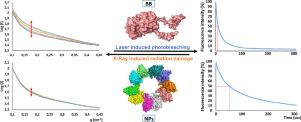https://www.sciencedirect.com/science/article/pii/S1742706119308050?via%3Dihub
DOI information: 10.1016/j.actbio.2019.12.003

Abstract
Fluorescent proteins are useful imaging and theranostic agents, but their potential superiority over alternative dyes is weakened by substantial photobleaching under irradiation. Enhancing protein photostability has been attempted through diverse strategies, with irregular results and limited applicability. In this context, we wondered if the controlled oligomerization of Green Fluorescent Protein (GFP) as nanoscale supramolecular complexes could stabilize the fluorophore through the newly formed protein-protein contacts, and thus, enhance its global photostability. For that, we have here analyzed the photobleaching profile of several GFP versions, engineered to self-assemble as tumor-homing nanoparticles with different targeting, size and structural stability. This has been done under prolonged irradiation in confocal laser scanning microscopy and by small-angle X-ray scattering. The results show that the oligomerization of GFP at the nanoscale enhances, by more than seven-fold, the stability of fluorescence emission. Interestingly, GFP nanoparticles are much more resistant to X-ray damage than the building block counterparts, indicating that the gained photostability is linked to enhanced structural resistance to radiation. Therefore, the controlled oligomerization of self-assembling fluorescent proteins as protein nanoparticles is a simple, versatile and powerful method to enhance their photostability for uses in precision imaging and therapy.
